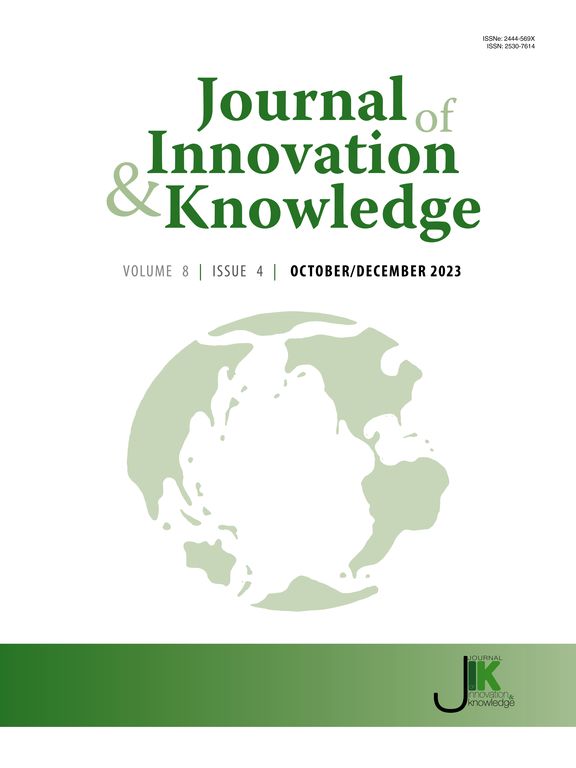探索知识管理和组织敏捷性在新兴市场中的作用
IF 15.5
1区 管理学
Q1 BUSINESS
引用次数: 0
摘要
世界各地的实体继续从事知识管理实践(KMP)和组织敏捷性(OA);然而,它们与企业组织间学习(IOL)和创新速度之间的关系却鲜为人知。此外,承担风险的理由被用作调节因素。采用偏最小二乘结构方程模型(PLS-SEM)进行假设检验。基于来自巴基斯坦拉合尔的294名参与者的数据,结果显示企业的KMP与OA、IOL和创新速度之间存在显著的正相关关系。同样,结果表明IOL和OA之间有显著的积极作用。此外,KMP与OA的关系受人工晶状体的显著影响。此外,企业的创新速度在知识绩效与OA的关系中起着显著的作用。同样,组织的风险承受能力与OA之间也存在正相关关系。最后,结果表明,较高的风险承受能力增强了IOL和OA之间的联系。首先,本研究通过关注OA的预测因素对现有学术文献做出了贡献。其次,本文综合KMP、IOL、创新速度和风险承受能力来确定OA。第三,运用资源基础观和知识基础观理论。这些发现强调了利用知识管理、组织灵活性和冒险行为来加速组织间学习和创新成果的重要性。这项研究为企业寻求在动态的知识经济中优化其运营和战略实践提供了重要的启示。本文章由计算机程序翻译,如有差异,请以英文原文为准。
Exploring the role of knowledge management and organizational agility in an emerging market
Entities worldwide continue to engage in knowledge management practices (KMP) and organizational agility (OA); however, little is known about their relationship with firms’ inter-organizational learning (IOL) and innovation speed. Moreover, risk-taking rationales are used as moderators. Partial Least Square Structural Equation Modeling (PLS-SEM) is used for hypothesis testing. Based on the data obtained from 294 participants based in Lahore, Pakistan, the results show a positive and significant relationship between firms’ KMP and OA, IOL, and innovation speed. Similarly, the results suggest a significant positive effect between IOL and OA. Furthermore, the relationship between KMP and OA is significantly influenced by IOL. Moreover, firms’ rate of innovation plays a significant role in the relationship between KMP and OA. Similarly, a positive correlation exists between organizations’ risk-taking tolerance and OA. Finally, the results show that a higher risk-taking tolerance enhances the connection between IOL and OA. First, this study contributes to the existing academic literature by focusing on predictors determining OA. Second, this article integrates KMP, IOL, innovation speed, and risk-taking tolerance to determine OA. Third, it employs resource-based and knowledge-based view theories. These findings underscore the importance of leveraging knowledge management, organizational flexibility, and risk-taking behaviour to accelerate inter-organizational learning and innovation outcomes. This research offers significant implications for companies seeking to optimize their operational and strategic practices in a dynamic, knowledge-based economy.
求助全文
通过发布文献求助,成功后即可免费获取论文全文。
去求助
来源期刊

Journal of Innovation & Knowledge
Multiple-
CiteScore
16.10
自引率
12.70%
发文量
118
审稿时长
37 days
期刊介绍:
The Journal of Innovation and Knowledge (JIK) explores how innovation drives knowledge creation and vice versa, emphasizing that not all innovation leads to knowledge, but enduring innovation across diverse fields fosters theory and knowledge. JIK invites papers on innovations enhancing or generating knowledge, covering innovation processes, structures, outcomes, and behaviors at various levels. Articles in JIK examine knowledge-related changes promoting innovation for societal best practices.
JIK serves as a platform for high-quality studies undergoing double-blind peer review, ensuring global dissemination to scholars, practitioners, and policymakers who recognize innovation and knowledge as economic drivers. It publishes theoretical articles, empirical studies, case studies, reviews, and other content, addressing current trends and emerging topics in innovation and knowledge. The journal welcomes suggestions for special issues and encourages articles to showcase contextual differences and lessons for a broad audience.
In essence, JIK is an interdisciplinary journal dedicated to advancing theoretical and practical innovations and knowledge across multiple fields, including Economics, Business and Management, Engineering, Science, and Education.
 求助内容:
求助内容: 应助结果提醒方式:
应助结果提醒方式:


